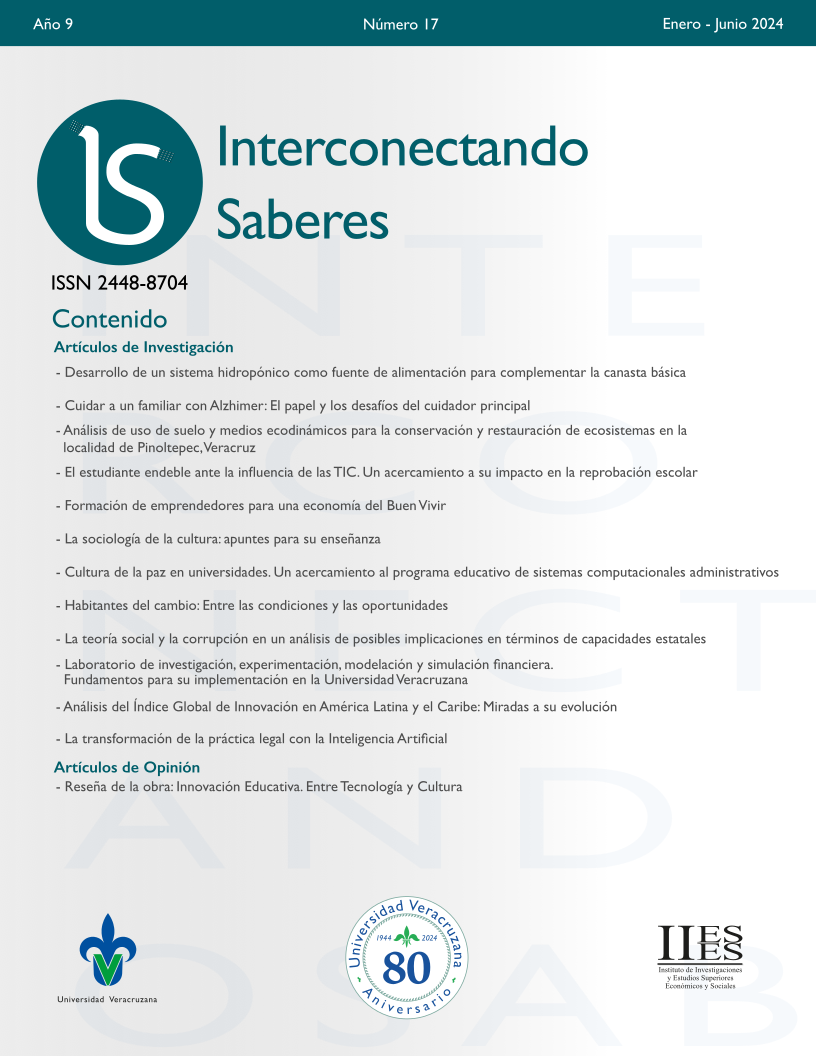Abstract
The Latin American and Caribbean region faces important challenges in terms of innovation. When studying aspects such as favorable environment, infrastructure, scientific and technological capabilities, qualified personnel, dissemination of results, industrial property and innovative products, within national innovation systems, their measurement must be taken into consideration as a vital point to make a comparison between countries. An analysis of the behavior of innovation is carried out by studying the Global Innovation Index of 17 countries in the area in the period 2019-2023. Lags are detected in various areas, regional division and the need to achieve an optimal relationship between the inputs and outputs of the innovation process. Countries such as Chile, Brazil and Mexico stand out with positive performances.
References
Acevedo, N. M., Jiménez, L. M., & Rojas, M. D. (2017). Análisis bibliométrico sobre indicadores de innovación. Revista ESPACIOS, 38(8), 10-23.
Aguilar-Barceló, J. G., & Higuera-Cota, F. (2019). Los retos en la gestión de la innovación para América Latina y el Caribe: un análisis de eficiencia. Revista de la CEPAL, 2019(127), 7-26. https://doi.org/10.18356/bd1b3729-es
Blacutt, J. A. A. (2021) La innovación, un tema recorriendo los caminos de la teoría de la administración. Perspectivas, 24(47), 123-138. http://www.scielo.org.bo/pdf/rp/n47/n47_a06.pdf
Comisión Económica para América Latina y el Caribe - CEPAL (2022). Ciencia, tecnología e innovación: cooperación, integración y desafíos regionales (LC/TS.2022/156), Santiago.
Comisión Económica para América Latina y el Caribe - CEPAL (2023). América Latina y el Caribe en la mitad del camino hacia 2030: avances y propuestas de aceleración (LC/FDS.6/3/Rev.1), Santiago.
Cornell University, INSEAD, & WIPO (2019). The Global Innovation Index 2019: Creating Healthy Lives – The Future of Medical Innovation. Ithaca, Fountainebleau and Geneva.
Cornell University, INSEAD, & WIPO (2020). The Global Innovation Index 2020: Who Will Finance Innovation? Ithaca, Fountainebleau and Geneva.
Escorsa, P., & Valls, J. (2003). Tecnología e Innovación en la empresa (1ra ed.). Barcelona: Ediciones UPC.
Fernández, R., Ricard, M., & Cordoves, D. (2021). Costo de la innovación: Un acercamiento teórico. Revista Cubana de Finanzas y Precios, 5(2), 64-75. http://www.mfp.gob.cu/revista/index.php/RCFP/article/view/07_V5N22021_RFEyOTROS
Freeman, C. (1995). The National System of Innovation in Historical Perspective. Cambrigde Journal of Economics, 19(1), 5-24.
Kong, D., Zhou, Y., Liu Y., & Xue L. (2017). Using the data mining method to assess the innovation gap: A case of industrial robotics in a catching-up country. Technological Forecasting & Social Change, 119, 80-97. https://doi.org/10.1016/j.techfore.2017.02.035
Lemarchand, G. A. (2010). Sistemas nacionales de ciencia, tecnología e innovación en América Latina y el Caribe. UNESCO, Uruguay.
Loray, R. (2017). Políticas públicas en ciencia, tecnología e innovación: tendencias regionales y espacios de convergencia. Revista de Estudios Sociales, 62, 68-80. https://dx.doi.org/10.7440/res62.2017.07
Lundvall, B. (2016). The Learning Economy and the Economics of Hope. Anthem Press. https://doi.org/10.26530/OAPEN_626406
Organization for Economic Co-operation and Development - OECD & Eurostat. (2018). Oslo Manual 2018: Guidelines for collecting, reporting and using data on innovation (4ta ed.). Luxembourg: OECD Publishing, Paris/Eurostat. https://doi.org/10.1787/9789264304604-en
Padilla, R., Gaudin, Y., & Rodríguez, P. (2013). Sistemas de Innovación. En CEPAL, Sistemas de innovación en Centroamérica: fortalecimiento a través de la integración regional (pp. 27-50). Santiago de Chile: Naciones Unidas.
Ponce, L. (2014). Capacidad Tecnológica y economía del conocimiento: ubicación del Perú en los rankings internacionales. Revista ECIPeru, 10(2), 45-51. https://doi.org/10.33017/RevECIPeru2013.0019
Rivera, J. A. (2012). La incidencia de la innovación sobre la creación de valor: propuesta de un modelo desde la perspectiva financiera. Revista de la Facultad de Ciencias Económicas, XX(2), 175-187. http://www.scielo.org.co/pdf/rfce/v20n2/v20n2a12.pdf
Roos, G. (2016). Design-Based Innovation for manufactoring firm success in High-Cost operating enviroments. SHE-JI The Journal of Design Economics and Innovation, 2(1), 5-28. http://dx.doi.org/10.1016/j.sheji.2016.03.001
Scarone, C. A. (2005). La innovación en la empresa: la orientación al mercado como factor de éxito en el proceso de innovación de producto. IN3:UOC. http://in3wps.uoc.edu/in3/es/index.php/in3-working-paper-series/article/download/n5-scarone/881-782-1-PB.pdf
Schumpeter, J. A. (1934). The Theory of Economic Development. Harvard University Press, 61-116. https://doi:10.1007/0-306-48082-4_3
Schumpeter, J. A. (1939). Business Cycles: A Theorical, Historical and Statistical Analysis of the Capitalist Process. New York: McGraw-Hill.
Sorescu, A., & Spanjol, J. (2008). Innovation’s effect on firm value and risk: Insights from Consumer Packaged Goods. Journal of Marketing, 72(2), 114–132. https://doi.org/10.1509/jmkg.72.2.114
World Intellectual Property Organization - WIPO (2021). The Global Innovation Index 2021: Tracking Innovation through the COVID-19 Crisis. Geneva.
World Intellectual Property Organization - WIPO (2022). The Global Innovation Index 2022: What is the future of innovation-driven growth? Geneva. https://doi.org/10.34667/tind.46596
World Intellectual Property Organization - WIPO (2023). The Global Innovation Index 2023: Innovation in the face of uncertainty. Geneva. https://doi.org/10.34667/tind.48220

This work is licensed under a Creative Commons Attribution-NonCommercial-NoDerivatives 4.0 International License.
Copyright (c) 2024 César Vega Zárate, Rafael Fernández Elías, Sergio Pozos Ceballos, Jerónimo Domingo Ricárdez Jiménez


